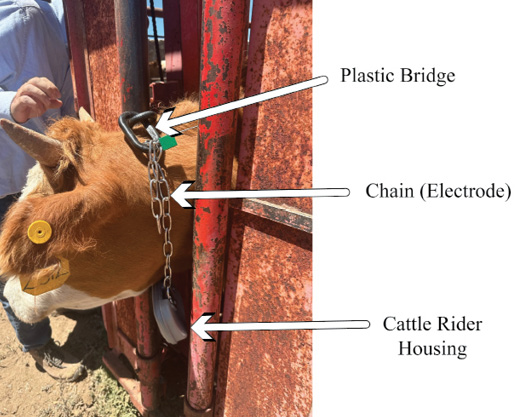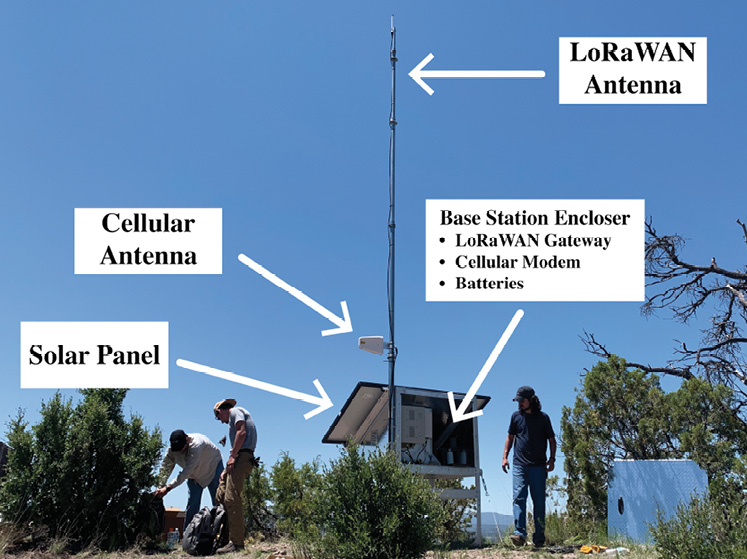Guide B-132
Craig Gifford, Santiago Utsumi, Marcy Ward, Pilja Vitale, Andrew Cox, Jeffrey Vitale, and Sara Marta
College of Agricultural, Consumer and Environmental Sciences, New Mexico State University
Authors: Respectively, Associate Professor, Department of Animal Range Science, New Mexico State University (NMSU); Associate Professor, Department of Animal Range Science, NMSU; Extension Specialist, Department of Animal Sciences and Natural Resources, NMSU; Extension Economist, Department of Extension Economics, NMSU; Farm and Range Manager, Department of Animal Range Science, NMSU; Associate Professor, Department of Agricultural Economics, Oklahoma State University; and Agriculture Extension Agent at Sierra County, NMSU. (Print Friendly PDF)
Ranchers set up a Vence e-collar on cattle. NMSU, 2023.
Rising Costs of Physical Fencing
New Mexico ranked 21st in U.S. livestock production1. The state is home to 1.3 million head of cattle and has 40 million acres of farmland, which places it 6th in the nation for total farm acreage. These rankings show that New Mexico ranching is extensive, based on large land holdings. Recent statistics indicate a decline of farms in New Mexico, while farm operating size has been on the rise. The state ranks 4th in the U.S. for largest average land size. New Mexico ranches typically stock cattle at rates up to 250 acres per head with operating sizes often exceeding 25,000 acres. The extensive nature of New Mexico ranching increases gathering costs in key seasonal operations such as marketing, vaccination, weaning, culling, and restocking. Recent economic trends have created labor shortages and rising labor costs from low labor participation, decreasing rural population, and upward pressure on minimum wage. Extensive ranching requires substantial investments in fencing, and the cost for these materials have skyrocketed. Traditional 5-wire metal fencing costs approximately $16,000 per mile, and this can rise to over $40,000 in difficult terrain. Higher fencing costs make interior fencing less viable, reducing pasture management options and increasing the likelihood of overgrazing and cattle loss.
A technological development to assist ranchers in alleviating these problems is virtual fencing. Virtual fencing tracks and contains livestock within prescribed boundaries established electronically, reducing labor and physical fence costs while generating improved grazing and animal welfare benefits. In this guide, we introduce Virtual fencing and explain how it is implemented. In a follow-up guide, we will explain the economics of introducing virtual fencing onto New Mexico ranches.
What is Virtual Fencing?
Virtual fencing is an integrated collar-based technology that uses a Global Positioning System (GPS), radio communication, and audio and electric warning signals to contain livestock within user prescribed perimeters (Figure 1). Virtual fencing requires a battery powered e-collar, access to either a commercially available cell phone tower or a local, user provided Long Range Wide Area Network (LoRaWAN) tower, and software typically installed on rancher’s cell phone (Figure 2). This guide assumes e-collar designed with GPS technology. Using this software, ranchers can track cattle and bound them within virtual fences via their cell phone or desktop computer. When an e-collar equipped cattle approaches the virtual fencing boundary, they first receive an audio warning that depending on the manufacturer, grows louder and eventually turns into an electric shock, similar to a traditional ground-based electric fence. A few days of training is initially required to ensure virtual fencing operation and animal safety.
|
Figure 1. Collar Technology used in Virtual Fence Application. |
|
|---|---|
|
GPS Transceiver:
LoRaWAN Transceiver:
Collar Memory:
Stimuli:
Battery:
|
|
Photos by Kim Crumbley, 2023. |
|
|
Figure 2. LoRaWAN Base Station. Photo by Santiago Utsumi, 2023. |
|
|---|---|
|
|
Base Station communicates with collars using LoRaWAN technology–ISM Band Cellular Backhaul bridges collar data to the internet Solar Panel allows operation in remote areas–includes battery storage. Depending on topography, each base station can cover 10,000-100,000 acres (>15km radius line of site) Designed to last 10+ years in the field with little to no maintenance |
Photo by Santiago Utsumi, 2023. |
|
What are the potential benefits of virtual fencing?
Virtual fencing has several benefits over physical fencing.
Tracking
Ranchers can track their cattle around the clock–24/7/365–using their cell phone or desktop computer dashboard, without physically visiting the field. With virtual fencing, ranchers know their cattle’s location, gaining valuable information about their grazing areas, proximity to water sources, and whether they are in predatory areas or sensitive environmental areas. Tracking saves days of labor, otherwise spent searching and locating cattle when herds need to be gathered for weaning, vaccinations, and marketing. Tracking gives ranchers a greater peace of mind knowing their cattle are well taken care of and out of danger. Ranch managers can assess animal forage efficiency performance by monitoring daily movement of each herd member to fine tune pasture boundaries and identify outliers that can be used when culling.
Replacing physical fencing
In many situations, virtual fencing can replace traditional metal fencing on the exterior perimeter. Even where exterior fencing is maintained, virtual fencing can prolong its life by preventing cattle from pushing up against existing fence. On the interior, it can more effectively and economically manage pasture, establishing a limitless number of pasture management applications. Cattle can be excluded from environmentally protected areas or rotated among targeted grazing areas while maintaining good water access. With access to forage mapping, virtual fencing can be combined with grazing management systems to enable precision grazing and generate additional benefits to New Mexico ranches.
What are the potential drawbacks of virtual fencing?
In some systems, technology often requires a higher upfront investment to install a network of radio communication towers for transmitting signals between e-collars and the ranchers’ computer. In other applications, a cellular communication plan is needed to ensure e-collar signal transmission, which in some rural areas may not be available. The e-collars must be worn at all times and can fall off livestock’s necks, especially in rough terrain, where it can become dislodged by plants or during encounters with predators. Additionally, e-collars need to have their batteries charged every 6 months and as cattle grow, they need to be re-adjusted to maintain proper fit. Both require gathering cattle, that can be a substantial added expense, especially in areas where cattle are managed on public grazing land. Fortunately, some e-collar systems use micro-solar panels to extend the life of the battery, helping reduce operation costs, and the tracking capability of virtual fencing reduces gathering time considerably.
Cattle need to be trained to the e-collar. Well trained cattle respond effectively to the initial audio warnings to avoid electric shocks. If not properly trained, cattle can “break-free” from virtual fencing boundaries or in other circumstances get confused and have difficulty in breaking free of the boundary, risking injury. Additional labor costs may arise from recovering escaping cattle, as cattle could be exposed to additional risks and dangers from being outside of prescribed ranging areas prior to recovery.
The exclusive use of virtual fencing as an exterior fence might not work well in all situations, especially in “fence-out” states such as New Mexico. Cattle from neighboring ranches that neither fence nor use virtual fencing would not be kept off ranches that use it as exterior fencing. Additionally, bulls are known to frequently lose their collars. Without a physical external fence, they will likely move to other pastures without hesitation.
|
Table 1. Summary of Virtual Fencing benefits and drawbacks compared with physical fencing. |
|
|---|---|
|
Benefits |
Drawbacks |
|
Tracking
Virtual fencing
|
|
How do I set up virtual fencing on my ranch?
Planning is the critical success factor to manage a virtual fencing ranch. Whether using radio or cellularband e-collars, ranchers are encouraged to visit and learn from other experienced users. When it comes to virtual fencing, there is no better experience than learning by doing. Ranchers are advised to collaborate early with the manufacturing supplier to define a deployment plan. It is recommended to begin planning at least 6 months prior to the startup date. The choice of system depends on several factors, including the required accuracy for livestock containment and grazing management plan, the collar power system, and the e-collar communication system. These factors can vary with the type of terrain and availability and location of cellular services. If long range radio communication is used, the network and location of receiving base stations must be designed for optimal communication. Tower requirements will vary depending on the size and terrain, as well as the location of cellular service. Training mature cattle during the dry phase is advisable as well as training all adult animals in a virtual fencing-herd. Startup plans must focus on the successful transition of livestock to the virtual fencing system. This transition phase must include plans for e-collar deployment (days -3 to) and initial training of livestock (days 1 to 7), and the first months of virtual fence use (days 7 to 90). Expect cattle to gradually learn to respond to simple virtual fencing grazing applications (i.e. virtual fence over existing physical fence) to applications of increasing degree of complexity (i.e. exclusion from riparian areas or rested vegetation patches). The length of the training phase, as well as the location, size, and layout of the training areas may vary depending on the ranch, the type of livestock, and rancher’s needs. Animals learn virtual fences from individual experiences and peers, so it is highly advisable to expose all animals to it at once; this will allow successful learning for each individual and helps to form a cohesive virtual fenced herd. Future success of virtual fencing use will largely depend on the success of this training and transition phase.
Where can New Mexico ranchers buy virtual fence?
Currently, two major companies sell virtual fencing products and their costs differ due to alternative e-collar design, app features, and digital interface. Vence is virtual fencing designed for large herds and large areas (flat or rugged). The system requires one or more transmitting towers depending on the area and terrain which may add to the costs of the system, but annual e-collar costs are less than other products since e-collar internet access is not required. Radio communication enables the use of the system in extensive remote areas where internet access is limited, but the tradeoff is reduced accuracy of e-collars (~50 m) for precise livestock contention. Vence e-collars require a replacement of battery that varies with use. Rotational grazing with intensive use of virtual fencing features may reduce battery life to 4-6 months. In contrast, light use of virtual fencing (i.e. over large perimeter areas only) may extend battery life up to 1 year. Using the Vence e-collars for cow position tracking only (without virtual fencing use) may further extend battery life beyond 1 year.
NoFence is a virtual fencing system designed for smaller herds (250 head) and precise applications on smaller grazing areas. The e-collars use cellular internet for two-way cattle-rancher communication. Therefore, towers are not required, but a large fraction of the overall cost is transferred to the price of each e-collar. Annual e-collar operating costs may be higher due to the need for cellular internet service. On the other hand, NoFence e-collars operate using micro solar panels. Panels can extend the life of a rechargeable lithium battery, reducing significantly labor costs associated with replacing batteries. NoFence collars are extremely accurate (~1 m) and highly suitable for precise containment of livestock in controlled grazing management applications, but the tradeoff will be of limited use in large remote areas with spotty cellular service. NoFence e-collars also monitor animal motion, offering additional applications as a precision livestock farming and monitoring tool.
Actual costs for both products are highly dependent on context. Ranchers should consider the application tradeoffs associated with each e-collar before purchasing products, which also vary with the characteristics of cattle, landscape, digital infrastructure, ranchers’ expectations and priorities, and fencing regulations. Stay tuned for our follow-up factsheet where the economic costs and benefits are laid out.
Conclusion
Virtual fencing is a viable management tool that can reduce labor cost and improve the operational efficiency for managing and handling livestock and can alleviate the high cost of installing a physical fence. Despite the tradeoffs mentioned above, e-collars can be a valuable tool for producers in New Mexico. They enable the management of large grazing areas with challenging terrain and help address difficulties in cattle grazing distribution.
References And Further Reading
- United States Department of Agriculture, National Agricultural Statistics Service, Mountain Regional Field Office. (2022). New Mexico Agricultural Statistics: 2022 annual bulletin. https://www.nass.usda.gov/Statistics_by_State/New_Mexico/Publications/Annual_Statistical_Bulletin/2022/2022-NM-Ag-Statistics.pdf
- Malpai Boardlands Group. (2023, December). Newsletter. http://www.malpaiborderlandsgroup.org/files/resourcesmodule/51b2274fc3d6c/2232231_Newsletter_2023_DIGITAL_VERSION_REDUCED.pdf
- Pfost, D., Gerrish, J., Davis, M., & Kennedy, M. (2000, November). Managed grazing system and fencing for distribution of beef manure (EQ379). University of Missouri Extension. https://extension.missouri.edu/publications/eq379
- Southwest Beef. (2023). Precision Ranching: Virtual Fence. https://southwestbeef.org/wp-content/uploads/twopager_precisionranching_final_508.pdf
Read Part 2: Virtual Fencing Using e-Collars vs. Physical Fencing Cost Comparison on New Mexico Cattle Ranches

Craig Gifford is NMSU’s Extension Beef Cattle Specialist. He earned his Ph.D. in animal physiology from the University of Idaho. His Extension work provides current research-based information to New Mexico beef producers to enhance profitability and ranch sustainability. In collaboration with county agents, he also organizes the ACES High Certified Calf Programs to promote Beef Quality Assurance practices and add value to New Mexico calves.
This work is supported by the Rapid Response to Extreme Weather Events Across Food and Agriculture Systems (A1712), #2023-68016-38885, from the U.S. Department of Agriculture’s National Institute of Food and Agriculture.
Brand names appearing in publications are for product identification purposes only. No endorsement is intended, nor is criticism implied of similar products not mentioned. Persons using such products assume responsibility for their use in accordance with current label directions of the manufacturer.
To find more resources for your business, home, or family, visit the College of Agricultural, Consumer and Environmental Sciences on the World Wide Web at pubs.nmsu.edu.
Contents of publications may be freely reproduced, with an appropriate citation, for educational purposes. All other rights reserved. For permission to use publications for other purposes, contact pubs@nmsu.edu or the authors listed on the publication.
New Mexico State University is an equal opportunity/affirmative action employer and educator. NMSU and the U.S. Department of Agriculture cooperating.
October 2024 Las Cruces, NM






